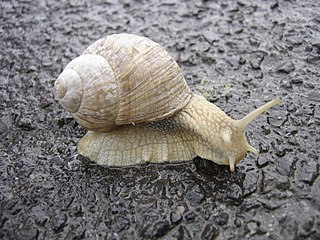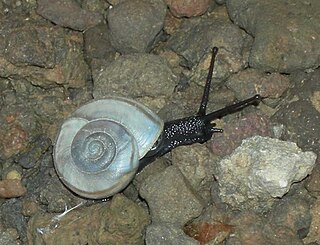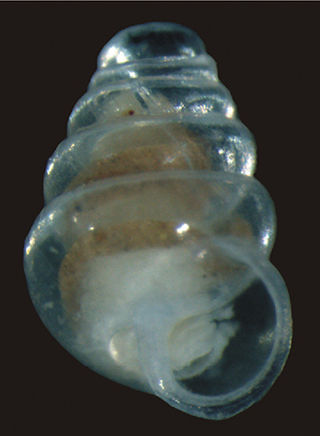
A snail is a shelled gastropod. The name is most often applied to land snails, terrestrial pulmonate gastropod molluscs. However, the common name snail is also used for most of the members of the molluscan class Gastropoda that have a coiled shell that is large enough for the animal to retract completely into. When the word "snail" is used in this most general sense, it includes not just land snails but also numerous species of sea snails and freshwater snails. Gastropods that naturally lack a shell, or have only an internal shell, are mostly called slugs, and land snails that have only a very small shell are often called semi-slugs.

Powelliphanta is a genus of large, air-breathing land snails, pulmonate gastropods in the family Rhytididae, found only in New Zealand. They are carnivorous, eating invertebrates, mostly native earthworms. Often restricted to very small areas of moist forest, they are prey to introduced mammalian predators, and many species are threatened or endangered.

Achatinella is a tropical genus of colorful land snails in the monotypic Achatinellidae subfamily Achatinellinae.

Cornu aspersum, known by the common name garden snail, is a species of land snail in the family Helicidae, which includes some of the most familiar land snails. Of all terrestrial molluscs, this species may well be the most widely known. It was classified under the name Helix aspersa for over two centuries, but the prevailing classification now places it in the genus Cornu.

Richard Thomas Lowe (1802–1874) was an English scientist, a botanist, ichthyologist, malacologist, and a clergyman. In 1825 he graduated from Christ's College, Cambridge, and in the same year he took holy orders. In 1832 he became a clergyman in the Madeira Islands, where he was also a part-time naturalist, extensively studying the local flora and fauna. He wrote a book on the Madeiran flora. He died in 1874 when the ship he was on was wrecked off the Isles of Scilly.

Sea snail is a common name for slow-moving marine gastropod molluscs, usually with visible external shells, such as whelk or abalone. They share the taxonomic class Gastropoda with slugs, which are distinguished from snails primarily by the absence of a visible shell.

Helicinidae is a family of small tropical land snails which have an operculum. They are terrestrial operculate gastropod mollusks in the superfamily Helicinoidea.

Helicidae is a large, diverse family of western Palaearctic, medium to large-sized, air-breathing land snails, sometimes called the "typical snails." It includes some of the largest European land snails, several species are common in anthropogenic habitats, and some became invasive on other continents. A number of species in this family are valued as food items, including Cornu aspersum the brown or garden snail, and Helix pomatia. The biologies of these two species in particular have been thoroughly studied and documented.

Aaadonta is a genus of air-breathing land snails, terrestrial pulmonate gastropod mollusks in the family Endodontidae. Specimens from this genus are endemic to Palau.

Zonitidae, common name the true glass snails, are a family of mostly rather small, air-breathing land snails, terrestrial pulmonate gastropod mollusks in the superfamily Zonitoidea.

Tree snail is a common name that is applied to various kinds of tropical air-breathing land snails, pulmonate gastropod mollusks that have shells, and that live in trees, in other words, are exclusively arboreal in habitat.

A land snail is any of the numerous species of snail that live on land, as opposed to the sea snails and freshwater snails. Land snail is the common name for terrestrial gastropod mollusks that have shells. However, it is not always easy to say which species are terrestrial, because some are more or less amphibious between land and fresh water, and others are relatively amphibious between land and salt water.

Achatinellidae is a family of tropical air-breathing land snails, terrestrial pulmonate gastropod mollusks in the superfamily Pupilloidea.

Camaenidae is a family of air-breathing land snails, terrestrial pulmonate gastropod mollusks in the superfamily Helicoidea, the typical snails and their allies. This is one of the most diverse families in the clade Stylommatophora.

The Helminthoglyptinae are a subfamily of air-breathing land snails, terrestrial pulmonate gastropod mollusks within the family Xanthonychidae.

Spiraxidae is a family of predatory air-breathing land snails, terrestrial pulmonate gastropods in the superfamily Testacelloidea.
The clausilium is a calcareous anatomical structure which is found in one group of air-breathing land snails: terrestrial pulmonate gastropod mollusks in the family Clausiliidae, the door snails. The clausilium is one part of the clausilial apparatus.

Freshwater snails are gastropod mollusks that live in fresh water. There are many different families. They are found throughout the world in various habitats, ranging from ephemeral pools to the largest lakes, and from small seeps and springs to major rivers. The great majority of freshwater gastropods have a shell, with very few exceptions. Some groups of snails that live in freshwater respire using gills, whereas other groups need to reach the surface to breathe air. In addition, some are amphibious and have both gills and a lung. Most feed on algae, but many are detritivores and some are filter feeders.
George Alan Solem, known professionally as Alan Solem, was an American malacologist, a biologist who studied mollusks.

Zospeum tholussum or the domed land snail, is a cave-dwelling species of air-breathing land snails in the family Ellobiidae. It is a very small species, with a shell height of less than 2 mm (0.08 in) and a shell width of around 1 mm (0.04 in). Z. tholussum individuals are completely blind and possess translucent shells with five to six whorls. The second whorl of their shells has a characteristic dome-like shape. They are also extremely slow-moving and may depend on passive transportation through running water or larger animals for dispersal.

















